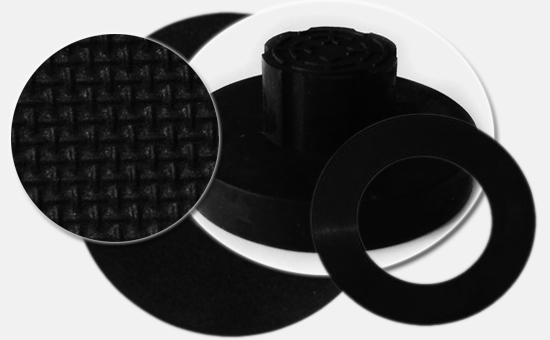
Chlorinated butyl rubber retains the butyl rubber double bond structure. Compared with butyl rubber, it has a faster vulcanization speed, better heat resistance, and smaller compression set. It is widely used to produce various types of rubber gaskets. Chlorinated butyl reclaimed rubber processed from waste medical bottle caps and stoppers as the main raw material can contain more than 60% of the rubber. Combined with chlorinated butyl rubber, it reduces the production cost of heat-resistant rubber gaskets and rationally adjusts each formula in the formula. The type and amount of the agent can further optimize the comprehensive index of the heat-resistant seal.
1. Low cost heat resistant gasket formula
50 parts of chlorinated butyl rubber, 70 parts of chlorinated butyl reclaimed rubber, 1.5 parts of stearic acid, 5 parts of zinc oxide, 3 parts of rubber accelerator, 50 parts of high wear-resistant carbon black, 15 parts of naphthenic oil, and antioxidant 1 part, 1 part light magnesium oxide, total: 196.5 parts.
2. Selection of heat-resistant gasket compounding agent
① It is mainly based on the accelerator DM, and the proper use of TMTD can improve the breaking strength of chlorinated butyl rubber / recycled rubber vulcanizate. The entire vulcanization system has fast vulcanization speed, long scorch time, and higher vulcanization effect and safety. Using appropriate amount of light magnesium oxide can play the dual role of acid absorption and promote vulcanization.
② Large use of high wear-resistant furnace black in the reinforced filling system can significantly improve the tensile strength, tear strength, wear resistance, and aging resistance of heat-resistant gaskets; it should be noted that the accelerator DM and TMTD are acid Accelerator and reinforcement white carbon black 1JLYY1216 is usually acidic, which will seriously affect the vulcanization of chlorinated butyl rubber / recycled rubber. Therefore, whether it is a black heat-resistant rubber pad or a light-colored rubber heat-resistant rubber pad, white carbon should be avoided. Black reinforcement.
③Phenol antioxidants, such as the typical antioxidant 2246, significantly improve the performance of heat-resistant oxygen aging, weathering resistance, flex aging resistance, and excellent protection of variable metals; use of chlorobutyl rubber and chlorobutyl When recycled rubber is used to produce heat-resistant rubber mats, the reasonable use of antioxidant 2246 can improve the adaptability of the gaskets to various environments and prolong the service life of the heat-resistant gaskets.
Studies show that when using chlorinated butyl reclaimed rubber in chlorinated butyl rubber gaskets to reduce production costs, after reasonable adjustment of the formula, the tensile strength of the gaskets can reach more than 15Mpa and the elongation at break is greater than 650%. Better resistance to compression and permanent deformation.
In the formula of heat-resistant seals produced by the combined use of chlorinated butyl rubber / recycled rubber, rubber product manufacturers choose appropriate chlorinated butyl recycled rubber, and determine the chlorinated butyl recycled rubber according to the specific needs of various indicators of heat-resistant seals. Dosage, rationally adjust the type and amount of each compounding agent in the formulation, reduce costs, and further optimize the quality of heat-resistant gaskets containing recycled rubber.
Exclusive original article [commercial authorization] reprint, excerpt and excerpt in any form are prohibited without written authorization. Focus on Hongyun rubber: learn the process formula and raw material technology of producing rubber products from recycled rubber to help you reduce costs and increase profits